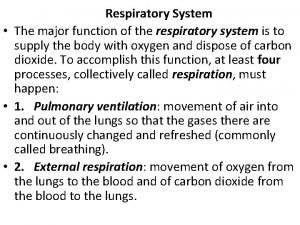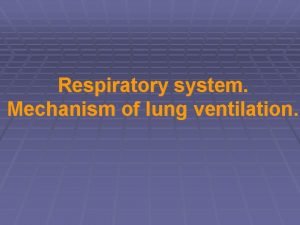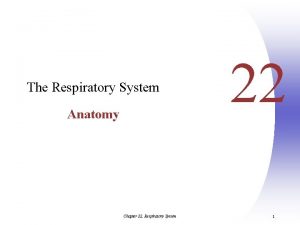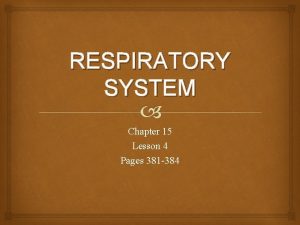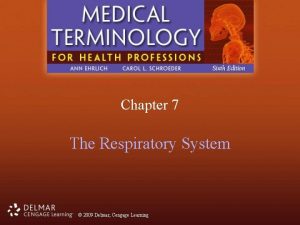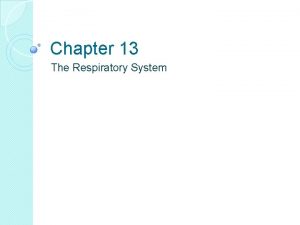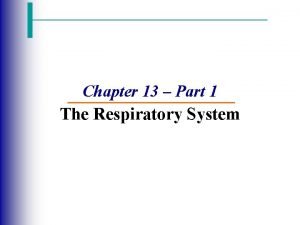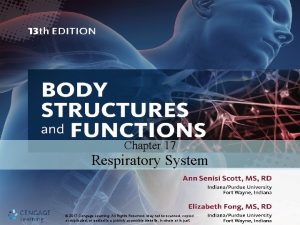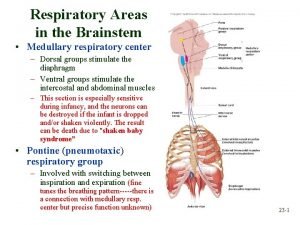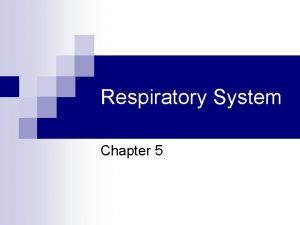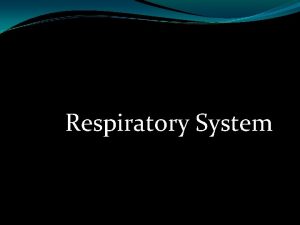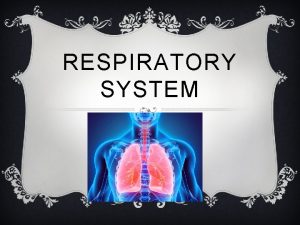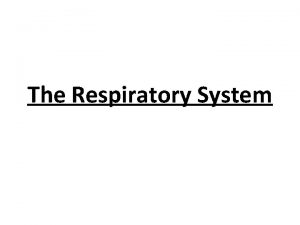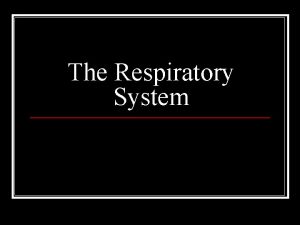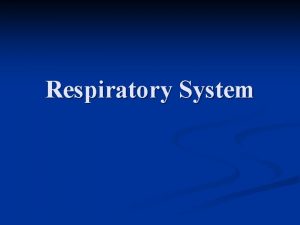Chapter 22 Respiratory System Function of the Respiratory





















- Slides: 21

Chapter 22 Respiratory System

Function of the Respiratory System • Supply the body with oxygen and dispose of carbon dioxide

Four Processes of Respiration • Pulmonary ventilation • External respiration • Transport of respiratory gases • Internal respiration

Pulmonary Ventilation • Movement of air into and out of lungs so that the gases are constantly being exchanged and refreshed. • Commonly known as breathing.

External Respiration • Movement of oxygen from the lungs to the blood and of carbon dioxide from the blood to the lungs

Transport of Respiratory Gases • Transportation of oxygen and carbon dioxide in the body. • Oxygen from the lungs to the capillaries (cells) • Carbon dioxide from the capillaries to the lungs (cells)

Internal Respiration • Movement of oxygen from the blood to the tissue cells and of carbon dioxide from the tissue cells to the blood.

Respiration • Only the first two processes are the actual responsibility of the respiratory system, but it can’t accomplish its primary goal unless the 3 rd and 4 th processes are also occurring! • The respiratory and circulatory systems are closely coupled!

Parts • Nose, pharynx (throat), larynx (voice box), trachea (windpipe), bronchi, and lungs.

Parts of the Respiratory System • Nose & nasal cavity • Only external part of the respiratory system. • Provides an airway for respiration. • Moistens, warms and filters air. • Resonating chamber for speech • Has olfactory (smell) receptors.

Nasal Cavity • Space within internal nose • Cavity is divided by the nasal septum • During breathing air enters the cavity by passing through the nostrils (external nares).

Nasal Conchae • Superior, middle, and inferior • Protrude medially from the lateral wall in the nasal cavity (like shelves) • Greatly increase the surface area and enhance air turbulence • gases swirl and turn, the heavier particles fall out and become trapped in mucous covering the “shelves”

Paranasal Sinuses • Surround the nasal cavity • Located in the frontal, sphenoid, ethmoid, and maxillary bones. • “Spaces” in the facial bones • Lighten skull • Warm and moisten air • Produce mucous – flows into the nasal cavity. • Blowing your nose helps drain the sinuses.

Paranasal Sinuses

Homeostatic Imbalance • Viruses, streptococcal • Sinusitis bacteria, allergens can • When the passageways to the cause rhinitis sinuses are blocked, the air in the • inflammation of the nasal cavity is absorbed causing a mucosa that is partial vacuum and a sinus accompanied by excessive headache mucus production, congestion and postnasal drip.

Pharynx • AKA - Throat. • Muscular tube extending from behind the nasal cavity to the larynx • Passageway for food and air, resonating chamber for speech, houses tonsils

Pharynx • Three regions: • A) nasopharynx • B) oropharynx • C) laryngopharynx A B C

• AKA - Voice box • 3 main functions: Larynx • Provides an open airway • Acts as a switching mechanism for food and air. • Sound production

Anatomy of Larynx - Epiglottis • Flexible, spoon shaped piece of elastic cartilage that covers the larynx when swallowing • Keeps everything going down the correct “tube” • If anything other than air enters the larynx, the cough reflex is triggered Epiglottis

Glottis • The “hole” seen at the opening of the larynx. • On either side you will see 2 strips of membranous tissue vocal cords (sound production) appear white because lack blood vessels.

Glottis • False vocal cords – above and lateral to the vocal cords. • Play no part in sound production but help close the glottis when we swallow
 Conductive zone vs respiratory zone
Conductive zone vs respiratory zone Respiratory digestive and circulatory system
Respiratory digestive and circulatory system Upper respiratory tract
Upper respiratory tract Conducting zone of the respiratory system function
Conducting zone of the respiratory system function What is larynx
What is larynx Tiny air sacs at the end of the bronchioles
Tiny air sacs at the end of the bronchioles Circulatory system and respiratory system work together
Circulatory system and respiratory system work together Pharyngorrhea
Pharyngorrhea Chapter 13 the respiratory system
Chapter 13 the respiratory system Perfusion respiratory system
Perfusion respiratory system Chapter 15 lesson 4
Chapter 15 lesson 4 Chapter 7 the respiratory system labeling exercises
Chapter 7 the respiratory system labeling exercises Chapter 34 section 1 the circulatory system
Chapter 34 section 1 the circulatory system Chapter 13 the respiratory system
Chapter 13 the respiratory system Chapter 13 respiratory system figure 13-1
Chapter 13 respiratory system figure 13-1 Chapter 17 respiratory system workbook answers
Chapter 17 respiratory system workbook answers Medullary center
Medullary center Hát kết hợp bộ gõ cơ thể
Hát kết hợp bộ gõ cơ thể Bổ thể
Bổ thể Tỉ lệ cơ thể trẻ em
Tỉ lệ cơ thể trẻ em Voi kéo gỗ như thế nào
Voi kéo gỗ như thế nào


